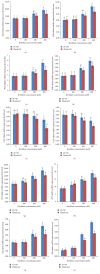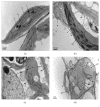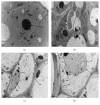Beryllium Stress-Induced Modifications in Antioxidant Machinery and Plant Ultrastructure in the Seedlings of Black and Yellow Seeded Oilseed Rape
- PMID: 29750147
- PMCID: PMC5884399
- DOI: 10.1155/2018/1615968
Beryllium Stress-Induced Modifications in Antioxidant Machinery and Plant Ultrastructure in the Seedlings of Black and Yellow Seeded Oilseed Rape
Abstract
Beryllium (Be) could be a threatening heavy metal pollutant in the agroecosystem that may severely affect the performance of crops. The present study was conducted to evaluate the toxic effects of Be (0, 100, 200, and 400 μM) on physiological, ultrastructure, and biochemical attributes in hydroponically grown six-day-old seedlings of two cultivars of Brassica napus L., one tolerant (ZS 758, black seeded) and one sensitive (Zheda 622, yellow seeded). Higher Be concentrations reduced the plant growth, biomass production, chlorophyll contents, and the total soluble protein contents. A significant accumulation of ROS (H2O2, OH-) and MDA contents was observed in a dose-dependent manner. Antioxidant enzymatic activities including SOD, POD, GR, APX, and GSH (except CAT) were enhanced with the increase in Be concentrations in both cultivars. Relative transcript gene expression of above-mentioned antioxidant enzymes further confirmed the alterations induced by Be as depicted from higher involvement in the least susceptible cultivar ZS 758 as compared to Zheda 622. The electron microscopic study showed that higher level of Be (400 μM) greatly damaged the leaf mesophyll and root tip cells. More damage was observed in cultivar Zheda 622 as compared to ZS 758. The damage in leaf mesophyll cells was highlighted as the disruption in cell wall, immature nucleus, damaged mitochondria, and chloroplast structures. In root tip cells, disruption in Golgi bodies and damage in cell wall were clearly noticed. As a whole, the present study confirmed that more inhibitory effects were recorded in yellow seeded Zheda 622 as compared to black seeded ZS 758 cultivar, which is regarded as more sensitive cultivar.
Figures




Similar articles
-
Comparative orchestrating response of four oilseed rape (Brassica napus) cultivars against the selenium stress as revealed by physio-chemical, ultrastructural and molecular profiling.Ecotoxicol Environ Saf. 2018 Oct;161:634-647. doi: 10.1016/j.ecoenv.2018.06.014. Epub 2018 Jun 19. Ecotoxicol Environ Saf. 2018. PMID: 29933133
-
Oxidative injury and antioxidant enzymes regulation in arsenic-exposed seedlings of four Brassica napus L. cultivars.Environ Sci Pollut Res Int. 2015 Jul;22(14):10699-712. doi: 10.1007/s11356-015-4269-1. Epub 2015 Mar 11. Environ Sci Pollut Res Int. 2015. PMID: 25752633
-
Chromium-induced physio-chemical and ultrastructural changes in four cultivars of Brassica napus L.Chemosphere. 2015 Feb;120:154-64. doi: 10.1016/j.chemosphere.2014.06.029. Epub 2014 Jul 11. Chemosphere. 2015. PMID: 25016339
-
Role of exogenous salicylic acid in regulating physio-morphic and molecular changes under chromium toxicity in black- and yellow- seeded Brassica napus L.Environ Sci Pollut Res Int. 2016 Oct;23(20):20483-20496. doi: 10.1007/s11356-016-7167-2. Epub 2016 Jul 26. Environ Sci Pollut Res Int. 2016. PMID: 27460028
-
Synergistic effects of chromium and copper on photosynthetic inhibition, subcellular distribution, and related gene expression in Brassica napus cultivars.Environ Sci Pollut Res Int. 2019 Apr;26(12):11827-11845. doi: 10.1007/s11356-019-04450-5. Epub 2019 Feb 28. Environ Sci Pollut Res Int. 2019. PMID: 30820917
Cited by
-
Physiological and Biochemical Mechanisms and Cytology of Cold Tolerance in Brassica napus.Front Plant Sci. 2020 Aug 12;11:1241. doi: 10.3389/fpls.2020.01241. eCollection 2020. Front Plant Sci. 2020. PMID: 32903421 Free PMC article.
-
Cold-tolerant introgression line construction and low-temperature stress response analysis for bell pepper.Plant Signal Behav. 2020 Jul 2;15(7):1773097. doi: 10.1080/15592324.2020.1773097. Epub 2020 Jun 10. Plant Signal Behav. 2020. PMID: 32522139 Free PMC article.
-
Integrated Transcriptomic and Proteomic Analysis Reveals Molecular Mechanisms of the Cold Stress Response during the Overwintering Period in Blueberries (Vaccinium spp.).Plants (Basel). 2024 Jul 11;13(14):1911. doi: 10.3390/plants13141911. Plants (Basel). 2024. PMID: 39065438 Free PMC article.
-
Protective mechanisms of melatonin against selenium toxicity in Brassica napus: insights into physiological traits, thiol biosynthesis and antioxidant machinery.BMC Plant Biol. 2019 Nov 21;19(1):507. doi: 10.1186/s12870-019-2110-6. BMC Plant Biol. 2019. PMID: 31752690 Free PMC article.
References
-
- Ali B., Qian P., Jin R., et al. Physiological and ultra-structural changes in Brassica napus seedlings induced by cadmium stress. Biologia Plantarum. 2014;58(1):131–138. doi: 10.1007/s10535-013-0358-5. - DOI
-
- Meng H., Hua S., Shamsi I. H., Jilani G., Li Y., Jiang L. Cadmium-induced stress on the seed germination and seedling growth of Brassica napus L., and its alleviation through exogenous plant growth regulators. Plant Growth Regulation. 2009;58(1):47–59. doi: 10.1007/s10725-008-9351-y. - DOI
-
- Yu R., Ji J., Yuan X., Song Y., Wang C. Accumulation and translocation of heavy metals in the canola (Brassica napus L.)-soil system in Yangtze River Delta, China. Plant and Soil. 2012;353(1-2):33–45. doi: 10.1007/s11104-011-1006-5. - DOI
MeSH terms
Substances
LinkOut - more resources
Full Text Sources
Other Literature Sources
Medical
Research Materials
Miscellaneous

